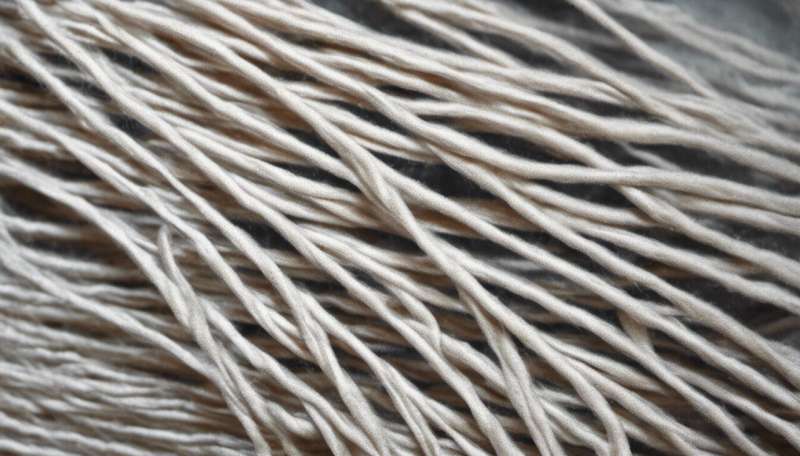Credit: AI-generated image (disclaimer)
The world has experienced massive disruption to supply chains in recent years as a result of the COVID pandemic and the war in Ukraine. This has restricted the availability of a wide array of goods, including essential items such as food, medicines and fuels.
In the UK, the challenges of creating new trade deals following Brexit and of meeting ambitious national net-zero carbon targets, have also led to discussions about what the UK should be importing versus producing at home to boost food security. But food isn't the only resource grown on farms—many of the clothes people buy on the high street can be traced back to a field.
Around 40% of the fibres used in the fashion industry globally come from plants or animals, with cotton being the biggest contributor. Most of this activity now takes place abroad, but textiles were once big business in the UK. Cotton mills dominated the landscape of the north of England when it was at the heart of the industrial revolution. Reviving this could provide a route to a more sustainable, "homegrown" UK textile industry.
The fashion industry is responsible for around 8-10% of global carbon emissions and nearly 20% of wastewater, not to mention a human rights record of low pay, long hours and poor working conditions. As consumers increasingly look for more sustainable and responsible clothing options, reinvigorating the UK textile industry could help to address these problems.
Our work with Homegrown/Homespun—a community initiative developing a line of naturally dyed linen jeans using UK-grown and spun flax—and the Centre for Global Eco-innovation's research student, Helena Pribyl, identified four benefits of redeveloping the UK textile industry. But it also highlighted four of the barriers to achieving this ambition.
First, the benefits.
1. Reducing emissions
Introducing a regenerative approach to growing clothing fibres like flax in the UK could help reduce emissions from farming. A recent study suggests that increasing soil carbon stores through regenerative arable farming in the UK could offset agricultural emissions by up to 25%. Regenerative farming techniques, like the use of organic manures and reduced tillage, not only reduce the greenhouse gas emissions from fertilisers, pesticides, and machinery but also help to sequester carbon in soils.
Emissions could also be reduced by cutting down on transportation between the field, raw material processing and retail stages of the clothing industry. Buying locally made textiles would help to substantially reduce the emissions per item of clothing. The ability to use less carbon-intensive energy generation would also be beneficial.
2. Increasing transparency
Manufacturing textiles locally would locate individual stages of the supply chain closer together, making them more observable and therefore less prone to unethical practices. It is undeniable that human rights abuses are a global problem—think of the issues identified in Leicester clothing factories during the pandemic. But such issues are a particularly acute concern in geographically dispersed supply chains and when sourcing from certain high-risk countries.
3. Boosting skills and sustainability awareness
Rejuvenating the UK textiles industry could help reconnect people with lost skills, crafts and culture. It could also contribute to sustainability awareness and help change lifestyle and consumption habits, especially when fields are located within local communities.
4. Growing local, rural economies
For rural economies, a renewed textile industry would bring job opportunities and potentially contribute to the UK's levelling up agenda. Harris Tweed is a prime example of the success of such a place-based business model. It brings employment to many sheep farmers, mill workers and independent home weavers in the Scottish Outer Hebrides and helps build the region's reputation globally, generating tourism and other economic benefits.
Now, what about those four barriers?
1. Space is limited
Space is at a premium in the UK, with a limited amount of land available for cultivation. Unless land unsuitable for growing food because of issues like contamination is used, producing flax or other clothing-related crops like indigo could come at the expense of national food production and the resilience of food supply chains. It is hard to argue that clothes should take priority over food, especially in the current economic climate.
2. Skills would take time to develop
Growing linen-quality flax and spinning it into a high-quality fabric takes a lot of skill. From farming clothing fibres and dyes, to processing and production, the UK has lost a lot of the skills needed to revive this industry at scale. Reskilling the UK in this regard would be a benefit, especially in regional areas that have struggled to replace the textile industry since it was offshored, but this would take time and require significant investment.
3. Economies of scale will be hard to achieve
The required facilities for textile manufacturing—for example, flax processing steps like scutching and retting, where the plant is beaten and softened—have been moved overseas. Many small initiatives working independently may struggle to make the economics of local textile production work. More collaboration will be needed to reach a sufficient scale to entice investment and bring the necessary physical infrastructure back to the UK.
4. Slow fashion is more expensive
Because of the increased cost of labour and energy, UK-grown and made clothing would be more expensive. It might therefore remain a niche product unless the public buys into the idea, helping it to form part of a broader fashion revolution. But this would require a cultural move away from disposable fast fashion towards durable, reusable, recyclable slow fashion.
The UK textile industry can't be regrown overnight. Resuscitating it will rely on the buy-in of a wide range of businesses, consumers and communities. Political support will also be needed to incentivise the reshoring of factories, train people and promote the growth of an inter-connected industry—from farm to coat hanger.
Provided by The Conversation
This article is republished from The Conversation under a Creative Commons license. Read the original article.![]()
























